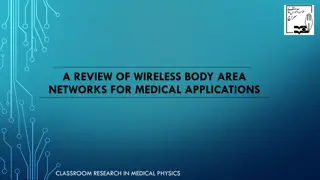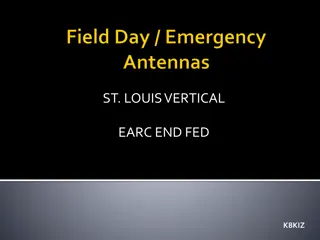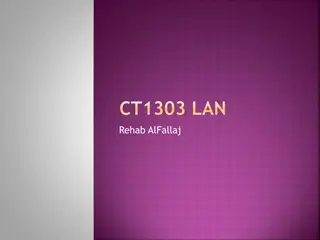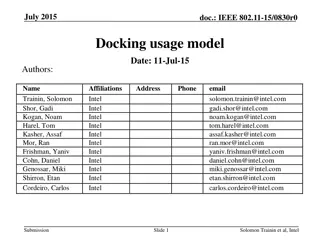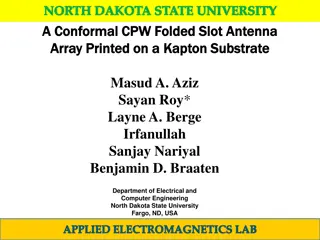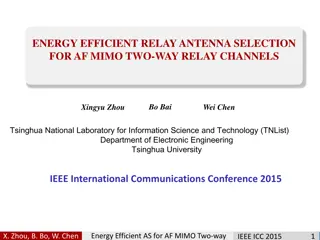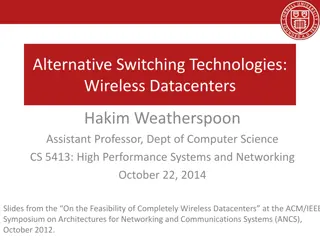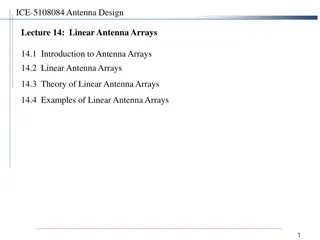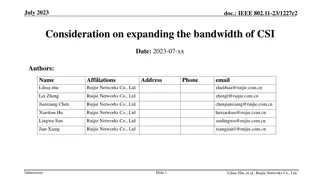Smart Antenna Systems Overview: Enhancing Wireless Performance
Smart antenna systems, like adaptive array antennas and switched beam antennas, combine antenna arrays with digital signal processing to transmit and receive signals adaptively. These systems improve signal quality, reduce interference, and increase capacity by dynamically adjusting radiation patterns. The classification of smart antenna systems includes switched beam and adaptive array types. The goals of smart antenna systems focus on enhancing signal quality and increasing capacity through focused transmission and frequency reuse.
- Smart Antenna Systems
- Wireless Technology
- Adaptive Array Antennas
- Switched Beam Antennas
- Signal Processing
Download Presentation

Please find below an Image/Link to download the presentation.
The content on the website is provided AS IS for your information and personal use only. It may not be sold, licensed, or shared on other websites without obtaining consent from the author. Download presentation by click this link. If you encounter any issues during the download, it is possible that the publisher has removed the file from their server.
E N D
Presentation Transcript
Smart Antenna Systems Yogesh Patidar
Overview What Is a Smart Antenna System? The Goals of a Smart Antenna System Signal Propogation: Multipath and Cochannel Interference The Architecture of Smart Antenna Systems
What Is a Smart Antenna System smart antenna system combines an antenna array with a digital signal-processing capability to transmit and receive in an adaptive, spatially sensitive manner. such a system can automatically change the directionality of its radiation patterns in response to its signal environment. This can dramatically increase the performance characteristics (such as capacity) of a wireless system.
Classification of smart antenna systems
Types of Smart Antenna Systems switched beam - a finite number of fixed, predefined patterns or combining strategies (sectors) adaptive array- an infinite number of patterns (scenario-based) that are adjusted in real time
Switched Beam Antennas Switched beam antenna systems form multiple fixed beams with heightened sensitivity in particular directions. These antenna systems detect signal strength, choose from one of several predetermined, fixed beams, and switch from one beam to another as the mobile moves throughout the sector.
Adaptive Array Antennas Adaptive antenna technology represents the most advanced smart antenna approach to date. Using a variety of new signal-processing algorithms, the adaptive system takes advantage of its ability to effectively locate and track various types of signals to dynamically minimize interference and maximize intended signal reception.
Goals of a Smart Antenna System The dual purpose of a smart antenna system is to augment the signal quality of the radio- based system through more focused transmission of radio signals while enhancing capacity through increased frequency reuse.
features of smart antenna system signal gain - Inputs from multiple antennas are combined to optimize available power required to establish given level of coverage. interference rejection - Antenna pattern can be generated toward cochannel interference sources, improving the signalto-interference ratio of the received signals. spatial diversity - Composite information from the array is used to minimize fading and other undesirable effects of multipath propagation. power efficiency - combines the inputs to multiple elements to optimize available processing gain in the downlink (toward the user)
Signal Propagation: Multipath And Co- channel Interference Multipath is a condition where the transmitted radio signal is reflected by physical features/structures, creating multiple signal paths between the base station and the user terminal
Conditions caused by multipath that are of primary concern are as follows: Fading - When the waves of multipath signals are out of phase, reduction in signal strength can occur. One such type of reduction is called a fade; the phenomenon is known as "Rayleigh fading" or "fast fading." phase cancellation - When waves of two multipath signals are rotated to exactly 180 out of phase, the signals will cancel each other. While this sounds severe, it is rarely sustained on any given call (and most air interface standards are quite resilient to phase cancellation). In other words, a call can be maintained for a certain period of time while there is no signal, although with very poor quality.
Counti delay spread - The effect of multipath on signal quality for a digital air interface (e.g., TDMA) can be slightly different. Here, the main concern is that multiple reflections of the same signal may arrive at the receiver at different times. This can result in intersymbol interference (or bits crashing into one another) that the receiver cannot sort out.
Counti.. Co-channel interference- One of the primary forms of man-made signal degradation associated with digital radio, co-channel interference occurs when the same carrier frequency reaches the same receiver from two separate transmitters.
Architecture of Smart Antenna Systems switched beam and adaptive array systems enable a base station to customize the beams they generate for each remote user effectively by means of internal feedback control. Generally speaking, each approach forms a main lobe toward individual users and attempts to reject interference or noise from outside of the main lobe.
Listening to the Cell (Uplink Processing) It is assumed here that a smart antenna is only employed at the base station and not at the handset or subscriber unit. Such remote radio terminals transmit using omnidirectional antennas, leaving it to the base station to separate the desired signals from interference selectively.
Speaking to the Users (Downlink Processing) The task of transmitting in a spatially selective manner is the major basis for differentiating between switched beam and adaptive array systems. As described below, switched beam systems communicate with users by changing between preset directional patterns, largely on the basis of signal strength. In comparison, adaptive arrays attempt to understand the RF environment more comprehensively and transmit more selectively.
Switched Beam Systems In terms of radiation patterns, switched beam is an extension of the current microcellular or cellular sectorization method of splitting a typical cell. The switched beam approach further subdivides macrosectors into several microsectors as a means of improving range and capacity. Each microsector contains a predetermined fixed beam pattern with the greatest sensitivity located in the center of the beam and less sensitivity elsewhere. The design of such systems involves high-gain, narrow azimuthal beamwidth antenna elements.
Adaptive Antenna Approach Adaptive arrays utilize sophisticated signal- processing algorithms to continuously distinguish between desired signals, multipath, and interfering signals as well as calculate their directions of arrival. This approach continuously updates its transmit strategy based on changes in both the desired and interfering signal locations
Smart Antenna Technology uses PCS, Cellular Comm wireless local loop (WLL)







